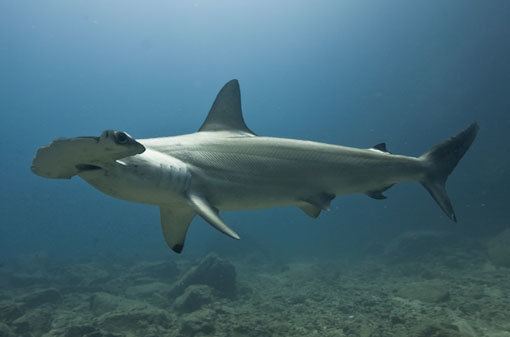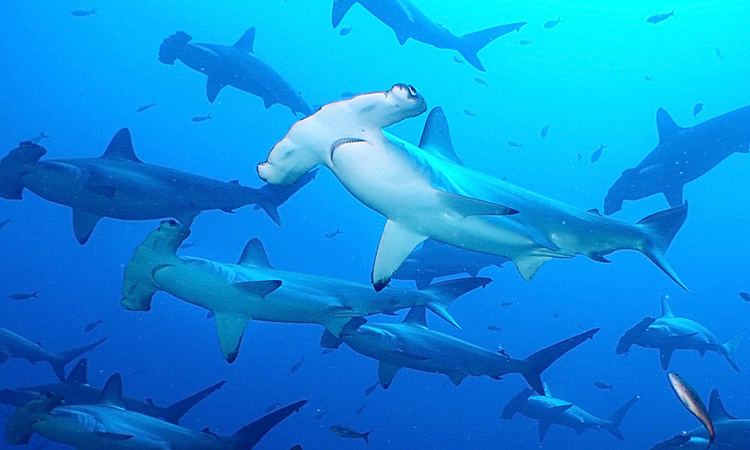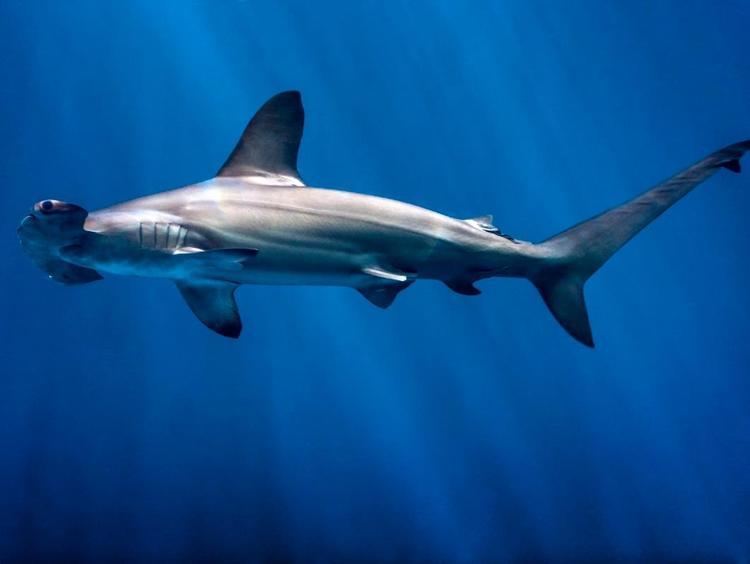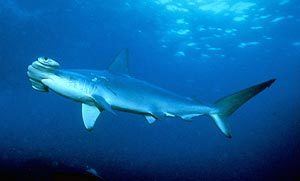Subclass Elasmobranchii Rank Species | Phylum Chordata Superorder Selachimorpha Family Sphyrnidae Higher classification Sphyrna | |
Similar Hammerhead shark, Shark, Sphyrna, Great hammerhead, Smooth hammerhead | ||
Scalloped hammerhead sharks shark academy
The scalloped hammerhead (Sphyrna lewini) is a species of hammerhead shark, and part of the family Sphyrnidae. Originally known as Zygaena lewini, the name of its genus was later renamed to its current name. The Greek word sphyrna translates into "hammer" in English, referring to the shape of this shark's head. The most distinguishing characteristic of this shark, as in all hammerheads, is the 'hammer' on its head. The shark's eyes and nostrils are at the tips of the extensions. This is a fairly large hammerhead, though is smaller than both the great and smooth hammerheads.
Contents
- Scalloped hammerhead sharks shark academy
- Scalloped hammerhead shark conservation in costa rica
- Taxonomy
- Description
- Distribution and habitat
- Schooling
- Sexual dimorphism
- Navigating behavior
- Reproduction
- Diet
- Human interaction
- References

This shark is also known as the bronze, kidney-headed, or southern hammerhead. It primarily lives in warm temperate and tropical coastal waters all around the globe between latitudes 46°N and 36°S, down to a depth of 500 m (1,600 ft). It is the most common of all hammerheads.

Scalloped hammerhead shark conservation in costa rica
Taxonomy

The scalloped hammerhead was first named Zygaena lewini and then renamed Sphyrna lewini by Edward Griffith and Hamilton Smith in 1834. It has also been named Cestracion leeuwenii by Day in 1865, Zygaena erythraea by Klunzinger in 1871, Cestracion oceanica by Garman in 1913, and Sphyrna diplana by Springer in 1941. Sphyrna comes from the Greek and translates into hammer.

It is a sister species to Sphyrna gilberti, differing by the number of vertebrae. Though once considered a distinct species, McEachran and Serret synonymized Sphyrna couardi with Sphyrna lewini in 1986.
Description
On average, males measure 1.5 to 1.8 m (4.9 to 5.9 ft) and weigh about 29 kg (64 lb) when they attain sexual maturity, whereas the larger females measure 2.5 m (8.2 ft) and weigh 80 kg (180 lb) on average at sexual maturity. The maximum length of the scalloped hammerhead is 4.3 m (14 ft) and the maximum weight 152.4 kg (336 lb), per FishBase. A female caught off of Miami was found to have measured 3.26 m (10.7 ft) and reportedly weighed 200 kg (440 lb), though was in a gravid state at that point.

These sharks have a very high metabolic rate, governing behavior in acquiring food. These sharks occupy tertiary trophic levels. The scalloped hammerhead shark, like many other species, uses the shore as a breeding ground. Due to high metabolic rates, young scalloped hammerhead sharks need a lot of food, or they will starve.
Distribution and habitat
The scalloped hammerhead is a coastal pelagic species; it occurs over continental and insular shelves and in nearby deeper water. It is found in warm temperate and tropical waters, worldwide from 46°N to 36°S. It can be found down to depths over 500 m (1,600 ft), but is most often found above 25 m (82 ft). During the day, they are more often found close to shore, and at night, they hunt further offshore. Adults are found alone, in pairs, or in small schools, while young sharks occur in larger schools.
Schooling
These sharks are often seen during the night,day, and morning. in big schools, sometimes numbering hundreds, most likely because large groups can obtain food easier than singles or small groups, especially larger and trickier prey, as commonly seen. The younger the sharks, the closer to the surface they tend to be, while the adults are found much deeper in the ocean. They are not considered dangerous and are normally not aggressive towards humans.
Sexual dimorphism
The female scalloped hammerheads undergo migration offshore at a smaller size than males because the larger classes of the hammerhead, such as those from 100 to 140 cm long, travel deeper down. Males and females differ in that males are observed to stay deeper than female sharks in general.
Sexual maturity generally occurs once the scalloped hammerhead attains 240 cm in total or longer. Physically, the mature females have considerably wider uteri than their maturing counterparts. A lack of mating scars has been found on mature females. Unlike females, males reach sexual maturity at a much smaller size.
The male-to-female ratio of the scalloped hammerhead is 1:1.29. Females probably are capable of giving birth annually. usually in the summer.
Navigating behavior
Scalloped hammerhead sharks have a homing behavior to navigate in the ocean. They move in the night and use the environment as a map, similar to a human reading a topographical map. By experimentation in tagging these sharks, one could test for any guidance in a shark’s movement. These sharks use a point-to-point type of school swimming, and do not favor going too deep where temperature changes hitchhike with current speed and directional change.
The scalloped hammerhead uses deep water to survive as safety and feeding. Although they have high metabolic rates, they have a tendency to be sedentary and allow currents to carry them as they swim. As a result, this causes the scalloped hammerhead to be selective where they swim and the depth at which they tend to stay. The scalloped hammerhead has a tendency to eat cephalopods.
Reproduction
The gestation period is reported to be around 12 months. Compared to other species, the scalloped hammerhead produces large litters, and this is most likely due to high infant mortality. Like most sharks, parental care is not seen. Nursery grounds for this species are predictable and repeated over the years, and they are faithful to their natal sites. Their natal sites still cause high infant mortality; a lack of resources prevents all the young from surviving. As a result, only the fittest grow to maturity. Also, should a population get depleted, it recovers through reproduction and not immigration. This species do not seem to attack each other even in periods of starvation. In addition, scalloped hammerheads have migratory behaviors. As a result, deprivation results from migration as well as young growth. While the Taiwan scalloped hammerheads seem to have an earlier maturity rate, it is still reported to be slow to mature.
Diet
This shark feeds primarily on fish such as sardines, mackerel, and herring, and occasionally on cephalopods such as squid and octopus. Larger specimens may also feed on smaller species of shark such as the blacktip reef shark, Carcharhinus melanopterus.
Human interaction
As of 2008, the scalloped hammerhead is on the "globally endangered" species list. In parts of the Atlantic Ocean, their populations have declined by over 95% in the past 30 years. Among the reasons for this drop off are over-fishing and the rise in demand for shark fins. Researchers attribute this growth in demand to the increase in shark fins as an expensive delicacy (such as in shark fin soup) and are calling for a ban on the practice of shark finning, a practice in which the shark's fins are cut off and the rest of the animal is thrown back in the water to die. Hammerheads are among the most commonly caught sharks for finning.
